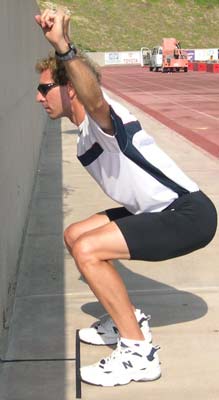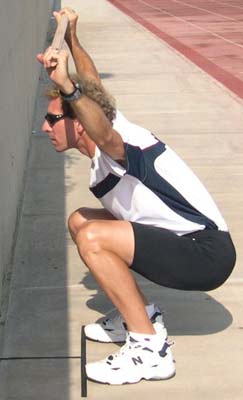| Ron Jones Bio |
| CorporateWellness |
| Coach & Train |
| Exercise Library |
| Handouts |
| Health & Fitness |
| KETTLEBELLS |
| Products by RJ |
| Site Map |
Mobility: "Overhead Reach Squat"
OBJECTIVE: Open ankles, hips, glute areas, shoulders, & lats.
The Overhead Reach Body-Weight Deep Squat is a great way to teach proper squat technique while also increasing functional mobility in the shoulders and upper back areas. Simply reach overhead with arms or use a dowel or broomstick while keeping arms straight.



-
Stand upright with feet squarely pointed forward and arms overhead with elbows straight.
-
Lower into squat as you keep weight evenly distributed across feet and reach pole overhead.
-
Keep heels down and don't compensate by allowing your toes to rotate out as you go down!
-
Keep arms straight overhead. Ideally, the line of your arms should be the same line as your spine--this is very important for getting maximum mobility of shoulders and lat areas of upper back.
-
Pause briefly on bottom to stabilize and control movement then come up as you lower arms back down.
-
Perform 5-10 reps.
![]() Tips: Keep feet straight forward and square!
Keep heels down while being careful not to sit back or lean forward. Keep
arms straight to actively stretch shoulders and lats. If you are leaning
forward too much, measure out two points 12" from a wall then place down some
tape. Align the center line with your crotch and put your toes on the line.
Squat down and keep your knees behind toes/tape and your face off the wall.
Tips: Keep feet straight forward and square!
Keep heels down while being careful not to sit back or lean forward. Keep
arms straight to actively stretch shoulders and lats. If you are leaning
forward too much, measure out two points 12" from a wall then place down some
tape. Align the center line with your crotch and put your toes on the line.
Squat down and keep your knees behind toes/tape and your face off the wall.
-
Squats are foundational exercises for leg strength and core development; however, many people cannot do them properly because of weak cores, tight ankles and calves, and/or weak gluteus medius muscles in the deep hips--or just bad joint mobility and functional movement in general. Remember--the best "free weight" is your own body weight! If you can't do a proper body weight squat then you have no business in the weight room adding more load on top of existing imbalances and resulting compensations. Learn to squat well with body weight and good joint mobility--then you'll be able to get optimum results with added loads in the weight room.
-
People usually ruin what can be a great lower body, core, and mobility exercise by compensating for imbalances. Common problems are rotating toes out (compensation for tight ankles, or calves, or weak glut medius, or all!). If you struggle to control the low positions you probably also have a weak core as this is a very "balance challenged" position without "the help" of counter balancing your body with the Olympic bar. Keep the arms straight overhead and get those shoulders and lats to stretch and "open up" through active movement.
-
NO--generally deep squats are NOT bad for you! (Note some people have injuries or limited mobility that prevents them from safely squatting) Thousands of people around the world deep squat every day to use the restroom, work, and carry on conversations. Americans can't deep squat well because we "sit" too much in furniture resulting in core weakness and restricted joint mobility. So get off your butt and squat!
- Mobility Exercises (Directions)
- Mobility Exercises (Organizer List Only)
*Note:
This exercise is intended for "normal healthy"
individuals. If you have an injury, or abnormal pain is present,
see your physician or a certified physical
therapist before continuing your exercises.
RonJones.Org | Back to Exercise Photos | Site Map
(Updated 5-28-05)
